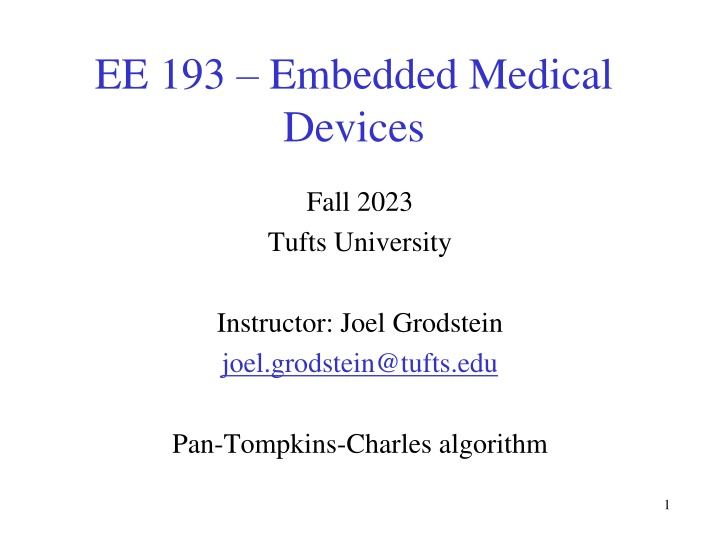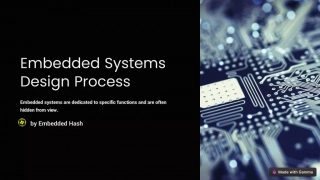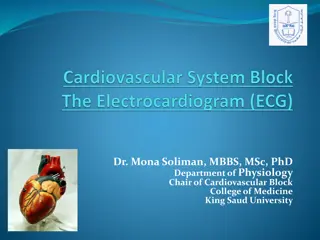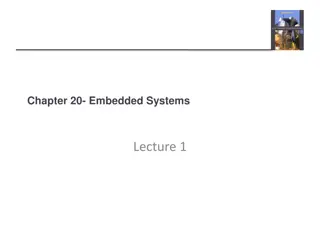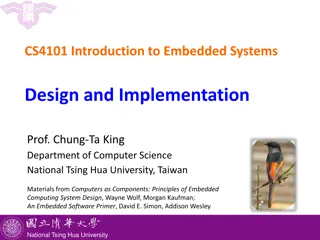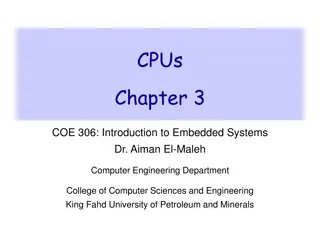Embedded Medical Devices - ECG Analysis and Algorithms
In this course at Tufts University, instructor Joel Grodstein teaches about analyzing ECG signals to find QRS complexes and compute heart rates. The course covers different algorithms for peak detection and addresses challenges such as varying signal voltages, 60Hz noise interference, RBBB ECG patterns, baseline drift, and setting lockout periods. Students explore solutions to these issues and apply algorithms for accurate heart rate calculations.
Download Presentation

Please find below an Image/Link to download the presentation.
The content on the website is provided AS IS for your information and personal use only. It may not be sold, licensed, or shared on other websites without obtaining consent from the author.If you encounter any issues during the download, it is possible that the publisher has removed the file from their server.
You are allowed to download the files provided on this website for personal or commercial use, subject to the condition that they are used lawfully. All files are the property of their respective owners.
The content on the website is provided AS IS for your information and personal use only. It may not be sold, licensed, or shared on other websites without obtaining consent from the author.
E N D
Presentation Transcript
EE 193 Embedded Medical Devices Fall 2023 Tufts University Instructor: Joel Grodstein joel.grodstein@tufts.edu Pan-Tompkins-Charles algorithm 1
Todays problem Given an ECG: Find the QRS complex Compute the heart rate (HR) EE 193 Joel Grodstein 2
First-try algorithm Find the peaks (using a derivative) Peak at >1v QRS Then HR is easy Problems? Everyone s voltage is different 1V EE 193 Joel Grodstein 3
Algorithm v2 Get running high and low peaks over 10 seconds Threshold = low + .9*(high-low) / 2 Any peak > threshold QRS Any problems with algorithm v2? high threshold low EE 193 Joel Grodstein 4
60Hz noise Get running high and low peaks over 10 seconds Threshold = low + .9*(high-low) / 2 Any peak > threshold QRS Any problems with algorithm v2? SHOW AN ECG WITH 60HZ NOISE!!!??? high low EE 193 Joel Grodstein 5
RBBB RBBB ECG typically has two distinct peaks First is the small partial peak from RBB conduction Next is the bigger peak from LBB wraparound SHOW MY RBBB ECG WITH TWO PEAKS!!!??? high low EE 193 Joel Grodstein 6
Baseline drift SHOW A BASELINE DRIFT ECG Drift may be too fast for the algorithm to keep up high threshold low EE 193 Joel Grodstein 7
Algorithm v3 Get running high and low peaks over 10 seconds Threshold = (low + high) / 2 Any peak > threshold QRS except if it s in the lockout period How do we set the lockout period? Max HR of a 20 year old 200 beats/minute 200 beats/minute = 60 sec/200 beat = .3 sec/beat So lockout for, say, .25 sec after any QRS Does it work now? In-class exercise EE 193 Joel Grodstein 8
Weird ECGs Show a tall P or Q giving a fast HR Exercise on your own: will lockout fix this? Onto the real algorithm In-class exercise EE 193 Joel Grodstein 9
Pan Tompkins Charles 1985: Jiapu Pan and Willis Tompkins published original algorithm 2023 Charles modified it for this course (unpublished) Working as an independent study Used Joel s ECG, and got it to work just before the summer ended EE 193 Joel Grodstein 10
PTC idea #1 Keep the running min peak & max peak Each new peak of height h min_peak = min (min_peak, h) max_peak = max (max_peak, h) thresh = (min_peak + max_peak) / 2 Every 2ms min_peak += delta max_peak -= delta This one is from C (PT had a different scheme) EE 193 Joel Grodstein 11
PTC idea #2 Work in two tracks Track #1 is what we described. And track #2 is QRS is not only tall, but also pointy Pointy means high slope = high derivative Process the signal with deriv_sq = (d(signal)/dt)2 run_avg = running_avg_over_200ms (deriv_sq) then do the same peak detect + min/max/thresh + lockout as in track 1 Only declare QRS if both tracks have a peak above their threshold at the same time EE 193 Joel Grodstein 12
PTC pros and cons Pros The PT part has been tested for over 35 years Unknown how much commercial usage Cons The C part was done with a looming deadline Hence, tested on only one ECG (Joel s) Will it work on yours? If not, you get to fix it EE 193 Joel Grodstein 13
Tour of the code Look at main.c for lab #6 EE 193 Joel Grodstein 14
Block diagram sample biquad filter filtered 5-point derivative peak detect deriv_2 peak_1 square deriv_sq_2 moving threshold running average thresh_1 avg_200ms_2 peak detect peak_2 moving threshold thresh_2 input > thresh input > thresh !refractory 15 dual QRS
